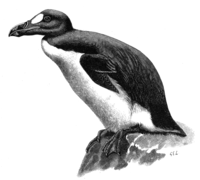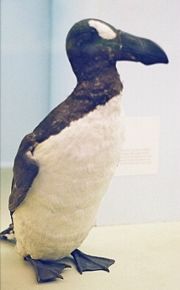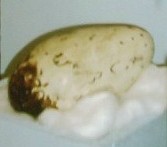Great Auk
2007 Schools Wikipedia Selection. Related subjects: Birds
| iGreat Auk | ||||||||||||||
|---|---|---|---|---|---|---|---|---|---|---|---|---|---|---|
 Great Auk by GE Lodge
|
||||||||||||||
|
|
||||||||||||||
|
Extinct (c. 1844)
|
||||||||||||||
| Scientific classification | ||||||||||||||
|
||||||||||||||
|
|
||||||||||||||
| Pinguinus impennis (Linnaeus, 1758) |
The Great Auk (Pinguinus impennis) is an extinct bird. It was the only species in the genus Pinguinus, flightless giant auks from the Atlantic, to survive until recent times, but is extinct today. It was also known as garefowl (from the Old Norse geirfugl), or penguin (see etymology below).
In the past, the Great Auk was found in great numbers on islands off eastern Canada, Greenland, Iceland, Norway, Ireland and Great Britain, but it was eventually hunted to extinction. Remains found in Floridan middens suggest that at least occasionally, birds ventured that far south in winter, possibly as recently as in the 17th century (Weigel, 1958).
Characteristics
Standing about 75 centimetres or 30-34 inches high and weighing around 5 kg (Livezey, 1988), the flightless Great Auk was the largest of the auks. It had white and glossy black feathers. The longest wing feathers were only 4 inches long. Its feet and claws were black. The webbed skin between the toes was brown/black. The beak was black with white transverse grooves. There was an area of white feathers on both sides of the head between the beak and each eye. It had a reddish/brown iris. Juvenile birds had less prominent grooves in their beaks and had mottled white and black necks.
Ecology
They were excellent swimmers, using their wings to swim underwater. Their main food was fish, usually between 12 and 20 cm, but occasionally up to half the bird's own length; based on remains associated with Great Auk bones on Funk Island and ecological and morphological considerations, it seems that Atlantic menhaden and capelin were favored prey items (Olson et al., 1979). Great Auks walked slowly and sometimes used their wings to help them traverse rough terrain. They had few natural predators, mainly large marine mammals and birds of prey, and had no innate fear of humans. Their flightlessness and awkwardness on land compounded their vulnerability to humans, who hunted them for food, feathers, and also for specimen collection for museums and private collections.
The Great Auk laid only one egg each year, which it incubated on bare ground, with hatching in June. The eggs were yellowish white to light ochre with a varying pattern of black, brown or greyish spots and lines which often congregated on the large end, and quite large (110-140 x 70-84 mm).
Extinction
The Great Auk was hunted on a significant scale for food, eggs and down from at least the 8th century. Previous to that, hunting by local natives can be documented from Late Stone Age Scandinavia and Eastern North America (Greenway, 1967), and from early 5th century AD Labrador (Jordan & Olson, 1982) where the bird only seems to have occurred as a straggler. A person buried at the Maritime Archaic site at Port au Choix, Newfoundland, dating to about 2000 BC, seems to have been interred clothed in a suit made from more than 200 Great Auk skins, with the heads left attached as decoration (Tuck, 1976). Nonetheless, opportunistic hunting by natives did not endanger the species as a whole.
The little ice age may have reduced their numbers, but massive exploitation for their down eventually reduced the population to very few birds. Specimens of the Great Auk and its eggs became collectable and highly prized, and collecting contributed to the demise of the species. Today about 80 preserved skins and approximately 70 eggs are known to exist. The last pair, found incubating an egg, were killed on 3 July 1844, on the island of Eldey off Iceland, though a later sighting was claimed of a live individual in 1852 off the Newfoundland Banks in Canada.
Today, around 75 eggs of the Great Auk remain in museum collections, and about again this number of skins. While literally thousands of isolated bones have been collected from 19th century Funk Island to neolithic middens, only a minute number of complete skeletons exist (Luther, 1996).
Systematics
Analysis of mtDNA sequences (Moum et al, 2002) have confirmed morphological and biogeographical studies in regarding the razorbill as the Great Auk's closest living relative. Interestingly, they were also closely related to the dovekie, which underwent a radically different evolution compared to Pinguinus. The entire lineage seems to have evolved in the North Atlantic. Due to the outward similarity to the razorbill (apart from flightlessness and size), the Great Auk was often placed in the genus Alca.
However, the fossil record (Pinguinus alfrednewtoni from the Early Pliocene Yorktown Formation of the Lee Creek Mine, USA) and molecular evidence demonstrate that the three genera, while still closely related, diverged soon after their common ancestor had spread to the coasts of the Atlantic.
Etymology
One theory connects names for the Great Auk with the origin of the word penguin, which may have come from the Welsh or Breton phrase pen gwyn, meaning "white head", referring originally to the Great Auk (although the head of the Great Auk was not in fact white, there are two white patches on its face). Later, when explorers discovered apparently similar birds in the southern hemisphere, what we now call penguins, the term was supposedly transferred to them. An alternative theory, suggested by John Latham in 1785, claims that the word penguin comes from the Latin pinguis meaning "fat", referring to the plump appearance of the bird.
The binomial impennis means "lacking remiges" in Latin; the remiges of this species are compact and small and possibly worked as vortex generators, if the had any function at all.
Trivia
The Great Auk is mascot to only one high school in the United States, Archmere Academy. It is also the mascot of Sir Sandford Fleming college in Ontario, Canada.

